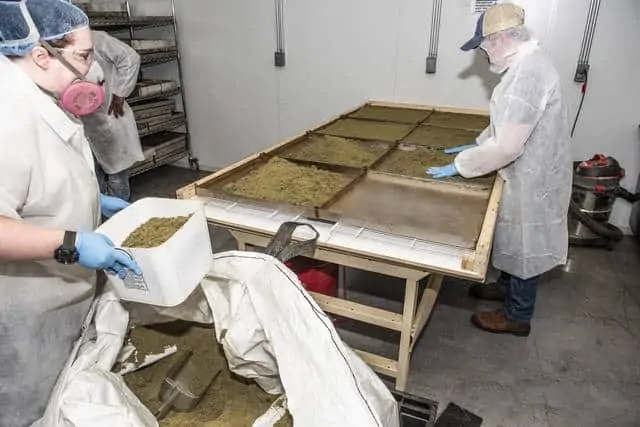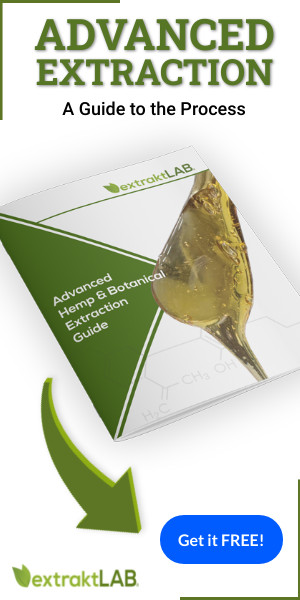Hemp Processing
This article is a detailed guide to hemp processing in hemp and CBD industry from plant to product. It covers a variety of techniques and topics including decortication, grinding, industrial hemp, how to make hemp oil, hemp flower processing, cannabinoid products, how to extract CBD and more.
Over the last 2-4 years, there has been an irrefutable boom in the industry of hemp processing. According to one report, the expected market growth of hemp production is estimated to reach a substantial $13 billion by 2023. This reflects the increasing demand for hemp and the incredible variety of products and services that stem from it.
But, the myriad of products that come from hemp are all derived from the processing of the plant. This involves planting, harvesting, shucking, separating, formulating and creating final products. So, let’s dive into the world of hemp processing and see just where these products come from.
What Is Hemp, And Why Is It So Amazing?
First things first: what exactly is hemp? Hemp is a particular species of the cannabis sativa plant that has been grown for industrial use for. Uses of this plant may include clothing, paper, paints, biodegradable plastics food products and more. This kind of hemp production has been used for tens of thousands of years and is continuing to grow exponentially.
Unlike its close cannabis cousin, marijuana, hemp tends to have far lower amounts of Tetrahydrocannabinol (THC), the compound that causes a “high” in the marijuana plant. However, recent uses of hemp have included the extraction and use of another common cannabinoid: cannabidiol (CBD).
CBD has exploded in popularity over the course of just a few years as producers have learned how to make hemp oil. While research is still being conducted, there are many studies that claim CBD to have numerous health benefits with user testimonies to match. Today, you will likely find everything from skin care products to vaporizers to edibles that contain this fascinating cannabinoid.
With a growing list of uses, hemp has been considered a somewhat limitless plant. But, in order to access its bevy of uses, the plant has to be processed into usable materials. In order to do that, we have to use specialized equipment.

Supercritical Extraction Machine
We have the perfect machine for small, medium and large producers. Our model line makes it easy for you to scale your operations while keeping your operating costs at a minimum.
A Quick Look at Hemp Processing Equipment
With the legalization of hemp in the 2018 Farm Act, a world of hemp derived products opened up, and with those products, the need for hemp processing equipment. Let’s examine some of that equipment here:
Combine: Similar to combines that harvest other crops, the combine is used to collect hemp stalks for industrial use; however, this kind of machinery would drastically reduce the capability to create CBD products as it compromises the quality of the hemp flower itself.
CBD Hemp Harvester: Used specifically to maintain the quality of hemp flower for CBD production, this machinery carefully cuts the hemp plant at the stalk and loads it together to reduce any damage to the flower. The same hemp processing equipment can be used for THC production from marijuana plants.
Decorticator: This particular piece of equipment is very important to create any kind of industrial hemp product. A decorticator separates the fibrous internal material from the stem of the plant. Both of these materials are used for separate purposes:
Industrial Hemp Materials
Bast (fiber): On the inside of the hemp stalk is a fibrous material called the “bast.” This material is commonly used in products like clothing, rugs, rope, and canvas. The common theme is that these products normally created from cotton, wool, silk, etc. can be replaced with a relatively prevalent source material. This is why hemp has been revered as a kind of “miracle crop” for its many applications.
Shiv (stem): In the very center of the hemp stalk is a tubular tough material called the “shiv” or “hurd.” This material is capable of being manufactured into a vast array of products including cement, insulation, paper, biodegradable plastics, animal bedding, mulch, and more.
Hemp Seed: There are many different uses for hemp seeds – most of them used as food products. Once they are hulled, hemp seeds can be eaten raw, pressed to make hemp oil, ground into meal, used in salad dressings, and much more.
Flower: Hemp flower is most often harvested for its cannabinoid content- namely CBD or cannabidiol. Though other cannabinoids are beginning to see frequent extraction and use from hemp flower, CBD in particular has swept the health and wellness market with scientific research and personal testimony that report numerous health benefits.
How Hemp Processing Works for Industrial and CBD Production
The applications of industrial hemp are seemingly endless, but how is industrial hemp processing done successfully? Let’s explore the process from start to finish.
The process to create cannabinoid products and industrial hemp products both start in similar fashion by harvesting the plant; however, the processes differ from this first step:
Industrial Processing
This process is often centered around the early stages of blooming as the focus lies primarily on the materials contained in the hemp stalk and not the flower. In order to separate those components into usable materials, decortication is necessary.
Cannabinoid Processing
The process of decortication is unnecessary as the focus lies on the cannabinoid rich flowers, not the fibrous materials from the stem of the hemp plant.The timing of this process is focused on the maturity of the plants flower to ensure high cannabinoid content and mature hemp seeds.
After the plant is carefully harvested to avoid damaging the valuable buds, the hemp is run through the shucking process. This uses equipment that separates the flower from the rest of the plant material. The reason for this is that the flower has a much higher cannabinoid content than the remainder of the plant. After the separated flowers and seeds have been tested for any unwanted residuals, they will be prepared for cannabinoid extraction and hempseed oil production.

What Industries Benefit from Hemp
Industrial Hemp
A primary function of the hemp industry is the manufacture of industrial hemp. By processing nearly every part of the hemp plant, producers are capable of creating a vast array of products from food and essential oils to clothing and even biofuel.
Industrial Products
Because of the versatility of industrial hemp there are nearly countless products that are hitting a variety of markets around the world. This includes: paper products, clothing, eyewear, composites, recyclable materials, hempcrete, jewelry, skin care products, biofuel, and conductive materials just to name a few.
Food Products
Hemp is very quickly finding its way to grocery store shelves and kitchen cupboards around the world. Many of its uses are considered to be healthy alternatives to food items that are consumed in large quantities including protein products, teas, energy bars, butter, milk, alcohol, flour, granola, cold pressed oils and more.
Cannabinoid Extraction
Apart from industrial hemp processing, the flower of the hemp plant also provides the opportunity for creating high quality, high value cannabinoid products through hemp oil extraction. There is a booming consumer demand for cannabidiol (CBD) products by which various extraction and distillation methods can be created, formulated, and marketed through hemp processing – let’s take a look through this side of the production process from start to finish.
Within recent years, the study and use of CBD has exploded in the hemp and cannabis industry as producers continue to learn how to make hemp oil. Various studies and user testimonies suggest that this cannabinoid could potentially aid a number of health issues including anxiety, insomnia, seizures, pain and more. While the FDA has not confirmed that this cannabis compound can treat any of these medical issues, further research continues to suggest that these claims are valid and a plethora of products have hit the shelves with this popular cannabinoid.
Extract Products
- Tinctures: CBD tinctures have become wildly popular in health communities with first-person reviews claiming that they help with anxiety, sleep, pain, seizures and other ailments.
- Vape Products: A great alternative to smoking tobacco products, CBD vape products are often considered to be less harmful than smoking. That being said, it is very important to consider the reputation of the company selling the vape product and to ensure user safety.
- Edibles: CBD and other cannabinoids extracted from hemp are currently being implemented into edibles such as gummies and other candies, baked goods, teas, sodas and more. As with tinctures, many users claim to have beneficial health effects from these products.
- Topicals: Another popular use for CBD is in topical products. These come in the form of face serums, lotions, salves, and pain remedy creams.
The Countless Benefits of Using Hemp
The list of benefits that hemp has to offer is vast for both consumers and producers alike. As hemp processing operations increase, the many benefits of this diverse plant will continue to reveal themselves in a number of ways.
Healthy Food Choices
As hemp continues to rise in popularity, a variety of healthy, hemp derived food items like hemp seed oil will continue to find their way to store shelves as well. These products could quickly replace less healthy food choices and provide readily available alternatives for many.
Countless Industrial Uses
As western civilization continues to advance, the utilization of hemp products continues to make progress. The beginnings of hemp alternatives are increasing in popularity in many facets of society including clothing, fuel, construction and more. Many of these alternatives are highly beneficial when compared to conventional products and could be rendered archaic as industrial hemp use increases.
Evidence for Medical Benefits
While research is still being conducted, there is a healthy amount of evidence that may prove CBD and other hemp derived cannabinoids to be beneficial for health and wellness. User testimonies claiming that these CBD products decrease anxiety, depression, pain and other health issues continue to show support for healthy medicinal alternatives in the form of hemp extracts.
Understand more about Supercritical CO2 Extraction through our FAQ’s and Hemp Extraction article.
Frequently Asked Questions
What is the solvent loss for ethanol extraction?
Hemp and cannabis biomass is an extremely absorbent material. As a consequence, a large amount of solvent volume must be added to the biomass to first solvate the biomass and then fluidize it. For ethanol extraction, approximately one gallon of ethanol is required to extract 1 lb of hemp. Solvent loss comes from the incomplete recovery of that solvent from the hemp.
The following table details the estimated solvent loss from ethanol extraction as a function of volume of hemp processed:
| Lbs processed per day | Daily requirement of
ethanol (gallons) |
Daily Loss of ethanol (gallons) at 90% recovery of ethanol | Max Cost of Solvent Loss per day:
$16-30/gal food grade ethanol $6-8/ gal denatured Calculated at $30/gal |
| 500 | 500-1500 | 50-150 | $1,500-45,000 |
| 1000 | 1000-3000 | 100-300 | $3,000-9,000 |
| 2000 | 2000-6000 | 200-600 | $6000-18,000 |
| 10000 | 10000-30000 | 1000-3000 | $30,000-90,000 |
Another source of solvent loss is incomplete recovery of solvent from the CBD hemp oil.
How many times can I recycle or reuse ethanol from an ethanol extractor?
In guidance published by the FDA in 2010, plans for the reuse of solvents must be accompanied by a Declaration of the maximum number of times the solvent can be reused.
the FDA has recognized that contaminants buildup in the solvent over time as they are recovered and reused
As a consequence, the FDA guidelines recommend that the solvents be brought back to a suitable state before Reuse. A suitable reuse is defined by the original specifications for the solvent that is being used.
In keeping with a risk-based approach to process validation, the key risk to address with solvent reuse is cross-contamination. Cross-contamination could happen when a solvent dissolves a low level contaminant from the biomass being extracted. As the solvent is removed, the contaminant can become magnified and concentrated in either the oil or the solvent during solvent recovery. Cross contamination then occurs when a contaminated solvent is used to extract a non contaminated batch.
Contaminants are typically identified during incoming inspection but may show up later during processing as the oil becomes more refined. Hemp is typically sampled at receiving by quality assurance and a series of tests are conducted on the Hemp biomass in order to determine if the incoming material is contaminated with pesticides, solvents, heavy metals or if it has significant microbial content. Contaminants that are identified in the quality inspection should be tested for build up in the extraction solvent during validation.
Other sources for contamination include carbon black or activated carbon that is typically used in ethanol extraction to remove chlorophyll from the ethanol. Combustion byproducts that are incorporated into the structure of carbon black can dissolve in the ethanol and contaminate.
According to FDA guidelines, the number of times ethanol solvent can be reused must be validated according to a validation protocol. Once the method and process has been validated, the requirements for testing each reuse batch may not be required depending on the risks identified during the validation study.
As a general rule of thumb, a solvent may be reused successfully 20-50 times. Whatever your company’s current practice is, it is important to define the process, validate the process, establish specifications for reuse, and also set up a testing program to measure for contaminants. In all likelihood, a solvent changeover is probably in your future and it’s cost should not be neglected in your overall operating cost model. It is easy to estimate the cost of solving change over as it is the same as the start-up cost:
| Lbs processed per day | Daily requirement of
ethanol (gallons) |
Cost per gallon:
$16-30/gal food grade $6-8/ gal denatured Calculated at $30/gal |
| 500 | 500-1500 | $15,000-45,000 |
| 1000 | 1000-3000 | $30,000-90,000 |
| 2000 | 2000-6000 | $60,000-180,000 |
| 10000 | 10000-30000 | $300,000-900,000 |
The solvent changeover cost on a 60 day change over cycle can then be estimated on a per year basis according to the following table:
| Lbs processed per day | Change Over Frequency | Cost of Changeover | Max Annual Cost |
| 500 | 60 days | $15,000-45,000 | $270,000 |
| 1000 | 60 days | $30,000-90,000 | $540,000 |
| 2000 | 60 days | $60,000-180,000 | $1,080,000 |
| 10000 | 60 days | $300,000-900,000 | $5,400,000 |
By extension, the solvent testing costs will also be important to address:
| Lbs processed per day | Change Over Frequency | Cost of Testing
(pesticides, solvents), Unknowns testing can be 5-10k USD per unknown. |
Max Annual Cost |
| 500 | 60 days | $200-400 | $2400 |
| 1000 | 60 days | $200-400 | $2400 |
| 2000 | 60 days | $200-400 | $2400 |
| 10000 | 60 days | $200-400 | $2400 |
It is important to insist that unknowns be flagged by your laboratory.
What is supercritical CO2 extraction?
Supercritical CO2 extraction is used in hemp processing in hemp extraction for extracting CBD oil from hemp biomass. You can also be used to extract any Botanical oil from any plant material.
The co2 extraction typically takes place above the supercritical pressure and temperature for CO2. Is 1,070 PSI and 31 degrees Celsius.
Under supercritical conditions, the CO2 behaves much like hexane in terms of its solubility selectivity.
Does ethanol extraction have a greater throughput than CO2 extraction?
Hemp processing equipment can be scaled for 1 to 5 tons of extracted hemp per day. It’s generally not a fair comparison to compare the throughput on an instrument from two different companies. What is fair is to specify the throughput At the tonnage process per day and then look at the operating cost for that process. You can also look at the equipment and Facilities cost to accommodate that level of Production. after you have all of your costs accounted for including the hidden costs, then you can calculate the net present value for each investment.
How much hemp can be processed per day with CO2 extraction?
CO2 extraction facilities have been scaled to do hundreds of tons per day of biomass extractions. These facilities are very safe compared to the equivalent extraction facilities that use Flammable solvents.
In Terms of extraction facilities for processing hemp, we have built facilities that will process 5 tons of hemp biomass per day in a safe, low cost, low energy, small footprint operation.
Does it cost less to process hemp with Co2 compared with Ethanol?
Yes.
In fact the operating cost for CO2 extraction is dramatically less than the operating costs associated with ethanol.
Extraction with Ethanol is a process that is typically run at low temperatures. First the ethanol is cooled to below -20oC before it is introduced to the hemp. Cooling the ethanol reduces the amount of extracted chlorophyll and waxes. If you account for the energy required to chill the ethanol down to those low temperatures and then also evaporate after use, the energy bill for extracting ethanol is approximately 3-6x the cost of extracting with CO2. However, the energy cost is really not the key driver in the overall operating costs.
Ethanol extraction requires a significant amount of ethanol to be used per pound of hemp. In fact, about 1 to 1.5 gallons of ethanol must be used per pound of dry hemp in order to extract. Hemp is a very absorbent biomass material and the ethanol must fully saturate the hemp plant before any extraction can take place. For this reason a large volume of ethanol is needed to extract cbd from hemp.
The key cost driver or ethanol extraction is recovery of that solvent from the biomass. Even though many ethanol extraction equipment companies provide centrifuges and or presses to eliminate the amount of ethanol left over in the biomass, The best equipment will provide only a 90 to 95% recovery of the ethanol. This 5 to 10% loss in ethanol is a huge cost driver for extracting ethanol.
For example, suppose you wanted to process 1000 lb of hemp. You would need 1000 gallons of ethanol to start out at a cost of $16-33 per gallon for food grade ethanol for a total cost of $16,000 to $33,000. If you recovered 90% of the ethanol the ethanol loss would be $1,600 – $3,300 per 1000 lbs. Furthermore if you process 1000 pounds per day, this would be your daily loss.
In contrast, you will lose the equivalent of about $70 per day for CO2 extractions for the exact same process.
Besides energy and solvent usage, there are many other hidden costs related to extraction with ethanol including solvent reuse costs, insurance cost, increased facilities cost, and testing costs.
What is the highest yield you can expect from hemp extraction?
Industrial Hemp extraction typically has a CBD content of 5 to 15% by weight. The THC content of the Industrial Hemp is required by law to be less than 0.3% by weight in the flower that is sold.
Does raw hemp moisture affect yield?
Yes, moisture content will affect weight yield. For example, if 10% of the hemp To be extracted was water, and that water was removed during CO2 extraction, the denominator would be larger in the yield calculation, thereby giving a smaller yield number. By extension, if the same hemp was extracted but had zero water in the hemp, the overall weight percent yield of the extract would be a greater percent of the weight.
One thing to note is that in ethanol extraction, water that is in the hemp will dissolve into the ethanol. If the ethanol is removed from the CBD oil with a falling film evaporator, some of the water will be Co evaporated with the ethanol, thereby increasing the amount of water in the ethanol for each extraction cycle. Some of the water will stay in the extract and is typically removed in a secondary stirred reactor before wiped film evaporator and distillation.
Do you offer training on hemp processing and hemp extraction?
We Have taught hundreds of customers how to extract CBD oils from hemp and THC oils from cannabis. Our training package typically includes installation of the equipment, standard operating procedures, commissioning of the equipment in the facility, and training of operators on the procedures that are provided.
We also offer advanced training and quality management system implementation services for those companies who wish to achieve GMP certification.This training dresses all aspects of the quality management system, laboratory information management, batch record system, and Manufacturing execution.
What kind of employees do you need for hemp processing or hemp extraction?
There are basically four different employees that you need to have in order to run a hemp processing or hemp extraction facility. These are as follows:
- assurance
- Shift manager
- Operators
- Optionally analytical operators.
If your goal is to produce a quality product that complies with GMP requirements, you are going to need to have staff that can help you comply with those requirements.That typically means you need to have a quality assurance manager that is aware of the requirements And can Implement those requirements in your facility.
It is also necessary that you have a shift manager. This is someone who is organized and can schedule operators at each station and track the production output. This person will also ensure that operator training has occurred, ensure that yields are met, and also manage the workforce. They are also responsible for producing products that can form with the quality requirements of the end product.
Operators typically execute on the production plan by following standard operating procedures. They are typically trained on how to use the equipment and how to move materials in and out of the process. It is their job to record the data for the quality management system. The Operators typically will be successful if they are Hands-On and are able to follow instructions. It is also a big Advantage if the operator can conduct basic maintenance on the equipment. This requires someone who is Hands-On and has the physical strength to do simple maintenance tasks. This is important for the proper running in the efficiency of a hemp processing facility.
Last but not least, analytical operators or quality control technicians are important for providing yield and in-process testing to the manufacturing facility. They will work with quality assurance directly to ensure that incoming raw hemp biomass conforms to purchasing specifications and to Quality specifications. Quality control technicians are typically chemists and have a laboratory background.






